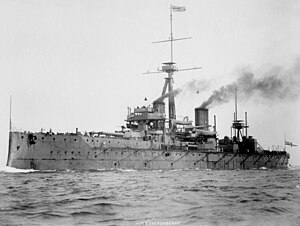

The dreadnought was the predominant type of battleship in the early 20th century. The first of the kind, the Royal Navy's HMS Dreadnought, had such an effect when launched in 1906 that similar battleships built after her were referred to as "dreadnoughts", and earlier battleships became known as pre-dreadnoughts. Her design had two revolutionary features: an "all-big-gun" armament scheme, with an unprecedented number of heavy-calibre guns, and steam turbine propulsion.[a] As dreadnoughts became a crucial symbol of national power, the arrival of these new warships renewed the naval arms race between the United Kingdom and Germany. Dreadnought races sprang up around the world, including in South America, lasting up to the beginning of World War I. Successive designs increased rapidly in size and made use of improvements in armament, armour, and propulsion throughout the dreadnought era. Within five years, new battleships outclassed Dreadnought herself. These more powerful vessels were known as "super-dreadnoughts". Most of the original dreadnoughts were scrapped after the end of World War I under the terms of the Washington Naval Treaty, but many of the newer super-dreadnoughts continued serving throughout World War II.
Dreadnought-building consumed vast resources in the early 20th century, but there was only one battle between large dreadnought fleets. At the Battle of Jutland in 1916, the British and German navies clashed with no decisive result. The term dreadnought gradually dropped from use after World War I, especially after the Washington Naval Treaty, as virtually all remaining battleships shared dreadnought characteristics; it can also be used to describe battlecruisers, the other type of ship resulting from the dreadnought revolution.[2]
- ^ Sandler 2004, p. 149.
- ^ Mackay 1973, p. 326, for instance.
Cite error: There are <ref group=lower-alpha> tags or {{efn}} templates on this page, but the references will not show without a {{reflist|group=lower-alpha}} template or {{notelist}} template (see the help page).